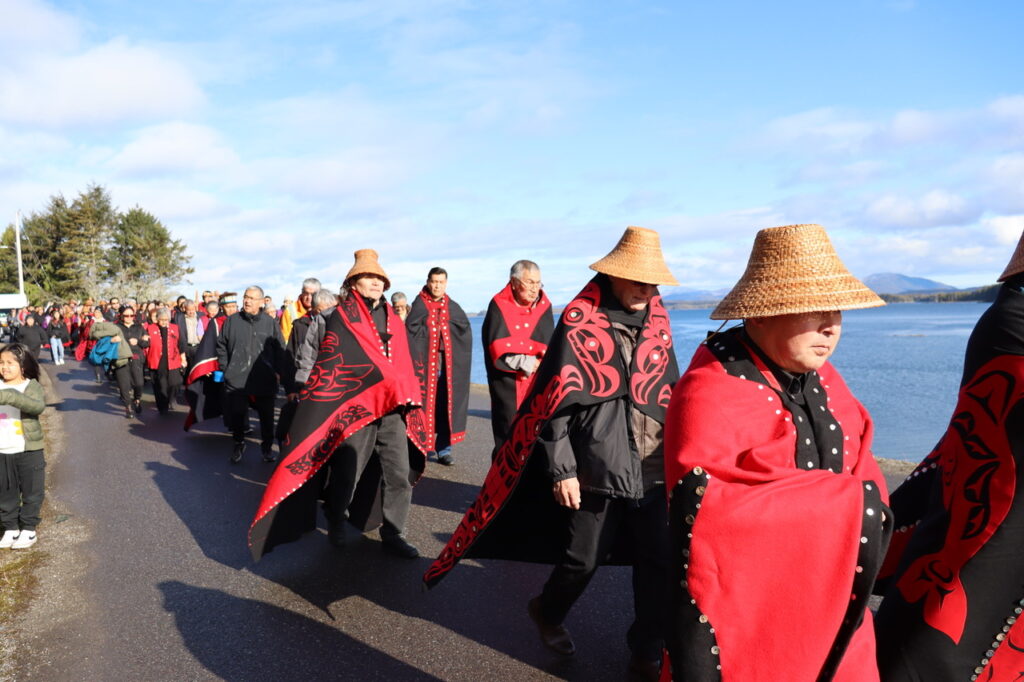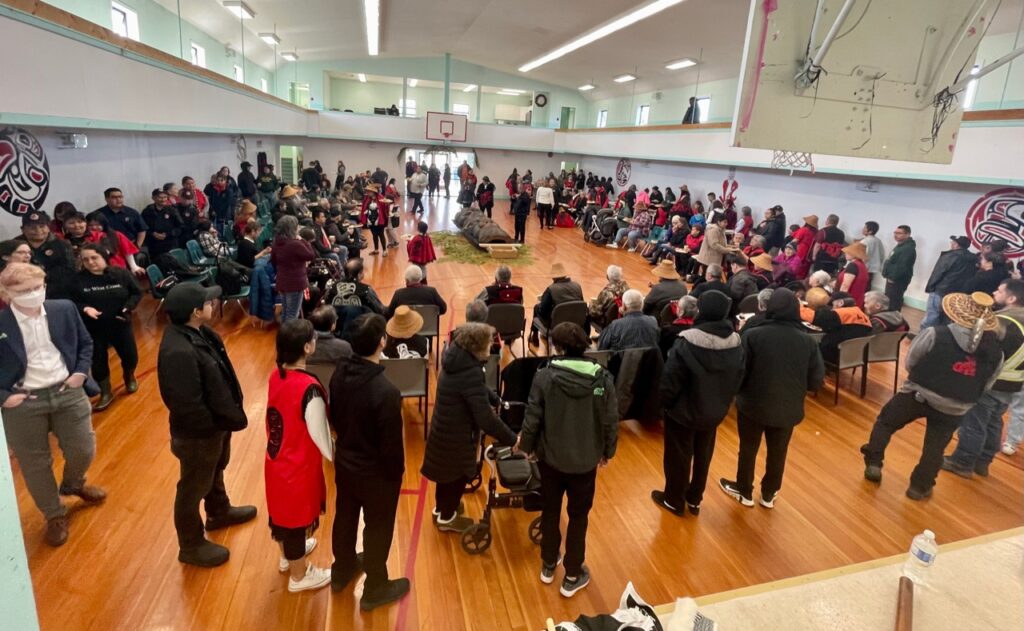A pts’aan, a totem pole belonging to the Gitxaała Nation — sold 126 years ago during one of their “darkest periods in living memory” — has returned home, blessed and reawakened, in the presence of their ancestors.
“It was significant for our people. It felt like it was a turning point for the Nation, to see something like this come home,” says Wilg’oosk Dustin Johnson, Cultural Program Manager for the repatriation work.
To welcome the pts’aan home, the Nation’s Elders and Hereditary Table decided to keep the event private, sacred, prioritizing Gitxaała-first, “because of how the pole had been desecrated,” Wilg’oosk explains. “Our people knew that we needed to treat this like a sacred living being, to apply our Ayaawx, our traditional laws and knowledge to approach this new situation — returning something of this significance.”
Wilg’oosk is from the Gispwudwada, the Blackfish Clan from Gitxaała. He lives in the village of Lax Klan. His mother is from an unbroken line from Lax Klan and his father’s side is Ganhada, Raven Clan from Lax Kw’alaams, from the Tsimshian people. Wilg’oosk has been leading the repatriation project as cultural program manager since moving home in November.
“It’s something I’ve always wanted to do. I did my own research as a teenager, joining my mother in meetings with Elders, many of whom are long gone now, learning about our Ayaawx and Adaawx, our traditional laws and stories,” says Wilg’oosk. “To be able to finally do this feels long overdue. The first project was this pts’aan, this totem pole.”
A long journey
The pts’aan was chosen to be brought home first, of the 73 other cultural treasures they’re bringing home from over 12 museums, across the country and abroad, because of its powerful significance in Gitxaała culture.
“It could very well be up to 200 years old,” he says. “We don’t know the specific carver of the pole. The carvers of that day, in that era — from the 1850s to 1890s — they didn’t have English names, some of them were hereditary leaders,” he says. “This pts’aan was a part of a larger pole that we believe was over 50 feet tall, originally.”
Missionaries of the time were pressuring his people to cut their poles down, settlers were cutting them down, selling them and burning them, he says.
“American collectors were coming up and down the Coast, collecting poles… our ancestors saved this 12-foot section and managed to repurpose it as an interior house post. Years later, in 1897, the missionaries pressured our people to sell the pole to the New England Fishing Company.”
The pts’aan was one of three left in the community at the time, significant to the Gitxaała people, evident even today through its intricate deep-cut carving, Wilg’oosk says.
“We know it was taken under duress, because at that time, a lot of our people were dying of smallpox, diseases introduced by colonizers. Our people couldn’t keep up with the burials, taking care of our dead… missionaries had vaccines, so many of our people accepted Christianity. That was a really dark time… around the same time the pts’aan was taken from the territory.”
The New England Fish Company kept the pole for 20 years, before selling it to the Peabody Museum at Harvard in Massachusetts where it had been kept in a warehouse, he says. The museum shared their accession files with the repatriation team which shed light into how the pts’aan and Gitxaała people were considered at the time.
“They shared an old newspaper clipping, an article from the Boston Globe in 1901,” Wilg’oosk says. “It was a very racist article. It was describing us in very racist terms, and that was shared with our Elders and our Nation, and the context in which it was taken from and how they talked about our pole and our people.”
It has been a long journey for the pts’aan. Several meetings were held to decide whether or not a delegation should travel to the museum, to have a cleansing ceremony while it was still at the University, but hereditary leaders decided to wait, to bless it when it’s in the Gitxaała home of Lax Klan.
“We just need to get it home, they said, and we’ll know what to do with it when we see it, when it’s in front of us. When it’s in our community, we’ll know how to handle it. But then we’ll go back to that museum, and leave a gan niidza, a marker, to explain what happened,” Wilg’oosk says.




‘Powerful, emotional, historic’
A large smorgasbord dinner was held in Prince Rupert, part of Gitxaała shared territory, as well as a blessing and cleansing ceremony for the pts’aan in the community hall before the feast in Lax Klan in early April.
“It was powerful, it was emotional. Some of our Elders — our oldest Elder is 96 — I could tell they didn’t really believe it would happen until they saw it in our community,” Wilg’oosk says. “When we marched it down the road from the float, up to the hall, we stopped at one of our Churches. That Church is built on top of a da’ax (a specific type of terraced Longhouse), one of our Bighouses. It was the Bighouse of Wiis’eeks. One of our hereditary Chiefs stopped and talked about it… he talked about this huge Longhouse and the power of that Chief (Wiis’eeks).”
It was a powerful moment to witness, he says, a clear “turning point” for the Nation in the work that was being done. The community hall was chosen to have the cleansing and blessing ceremony and to hold the pole until a cultural centre is built for all returning items. Four clan leaders, the present, highest-ranked hereditary leaders of each clan, blessed the pole with traditional medicines and messages in Sm’algyax, Wilg’oosk shares.
“One of our leaders, speaking in our language of Sm’algyax, was addressing our ancestors, calling them, inviting them in,” he says. “We felt how spiritually-charged it was in that hall — that hall has always had a lot of spiritual activity. That pole was right in the middle of that hall, right at centre court.
We were calling the ancestors to come in for a healing moment, with the packed hall of our community.
It was a historic moment for his people. The community has had several deaths over the past year and held a lot of memorial and stone-moving feasts, but the returning home celebration felt like the “reverse of a death feast.”
“We felt it when we had that ceremony and our Elders and hereditary table were breathing life and energy back into that pole. We were reawakening, guided by our culture, and we really felt it.”
Many of the community’s Elders and hereditary leaders had just returned from Vancouver, participating in an ongoing precedential legal challenge against BC’s mineral claim regime. Less than half an hour after they returned, the delegation was brought to the Civic Centre in Prince Rupert for the first celebration of the pts’aan’s return.
“After being away for two weeks at the court case, most of our Elders and Hereditary Table participated in events back-to-back, our dinner in Prince Rupert, and then the feast in the village. We planned it out that way,” he says.
“This court challenge is about protecting our territory, and the significance of a totem pole being the maker of our territory, defense of our territory, but also telling the history to back it up, was symbolic for our Elders to come back and be a part of that… as tired as they were, it reinvigorated everyone.”



‘Part of our living culture’
The repatriation committee, guided by Gitxaała Elders, senior high-ranking people, has reawakened Sm’algyax language in the process of returning treasures home. Words like ‘artifact’ and ‘repatriate’ were replaced by Sm’algyax words and its closest phrases, putting the “value and sacredness back in.”
“The word ‘artifact’ is such a loaded colonial word that implies that our culture died off. It’s not an artifact, it’s part of our living culture. We’re still alive,” Wilg’oosk says. “We came up with phrases in our language… we had to differentiate between what’s already come home, what’s on its journey home, and what we still need to bring home. We were really challenging our committee, with our Elders, to try and find the right phrase, the right way to explain it in our culture.”
Wilg’oosk traveled with a delegation of five Elders to Victoria and Vancouver, to visit the Royal BC Museum and the Museum of Anthropology in the months leading up to the celebration. One of the Elders, 84, from the Laxgibu, Wolf Clan, told the group a story of when her grandmother was taking her out on one of our islands, harvesting, pulling bark, weaving baskets, “speaking to it, breathing life into it, and infusing it with their Spirits,” Wilg’oosk says.
“When you see a basket, it’s like speaking to the Spirit of your great-grandmother, of our ancestors. So that’s what made it real for us, especially with this pole… speaking to the Spirit of our ancestors that carved it, that took care of it, kept it alive for us.”
Many Gitxaała Elders often talk about how Lax Klan is the “oldest living community on the coast,” continuously occupied by Gitxaała people, Wilg’oosk says. The band council system was only set up (in Lax Klan) in the 1940’s, and for thousands of years prior, the Nation was ruled by their traditional hereditary system, the Ayaawx and Gugwilx’yaansk. Wilg’oosk says his Elders told him they weren’t going to use Christianity during this work of welcoming and blessing the pts’aan, and instead the Elders, Hereditary Table, and everyone involved stood on and reactivated the Ayaawx, Gitxaała traditional laws.
“This is just the first of many to come.”
Listen to Dustin Johnson introduce himself and speak about the power of the pts’aan returning home:


